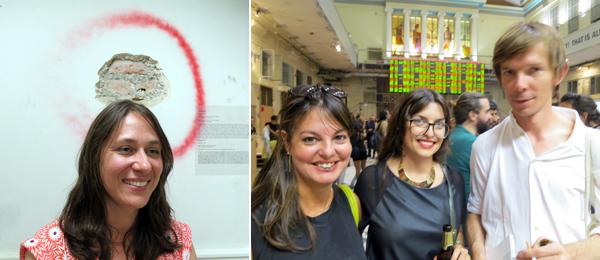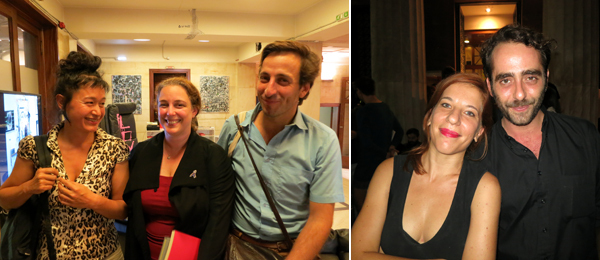Occupational Hazards
“THIS IS NOT A BIENNIAL,” said Athens Biennale codirector Poka Yio as
he introduced its fourth iteration, “Agora.” “It is not an exhibition.”


This nonbiennial nonexhibition is the result of a collective experiment
carried out by a “nameless and ephemeral group of artists, curators,
theorists, and practitioners,” and seeks creative alternatives to a
state of bankruptcy. Starting months before with weekly meetings of
three teams, it ended with the occupation, fittingly, of the former
Athens Stock Exchange building. The whole thing is a sort of ongoing
performance: The point is, you have to be here.
The air of mystery shrouding the process, in spite of the number of
people involved (some thirty curators), gave it a buzz that was enhanced
and eclipsed in equal measure by current events. The day of the
preview, Saturday, September 28, was dominated by widespread euphoria
over that morning’s arrest of leaders of the Golden Dawn party, whose
neo-Nazi members had perpetuated fear and loathing on the streets,
beating and killing immigrants, since their election to parliament in
2012. Spurred by the slaying of a Greek, a young antifascist rapper,
that day was the first time since the demise of the dictatorship in the
1970s that MPs had been put under arrest, and seemed proof of the
government’s willingness to rout out corruption. “It’s crazy,” said
curator Daphne Vitali as we dashed to the press conference on her
motorcycle. “My little sister spent the night at the police station,”
caught up in a protest sweep the day after the killing.

Like the Athenian agora, where classical brainstorms took place in the
form of power lunches, this biennial is an open platform for discussion,
with daily workshops, screenings, performances, lectures, concerts, and
a forum on Sundays—a democratic takeover of an extinguished capitalist
structure. Nikos Xydakis, editor in chief of Kathimerini, ignited a
heated exchange when he questioned whether the public would really
participate or just the usual group of hipsters. “Why do we have to be
so cynical?” curator Katerina Gregos retorted.
Artist duo Fyta had already set up their “camp” in the middle of the
main hall to facilitate a weeklong “Situationist burlesque,” complete
with a self-devotional shrine and the continuous video Quotedious,
exploring boredom as a constitutive force for creativity (alongside
unemployment, perhaps). Among their workshops would be “Facebook
Unfriending Advice” and “The Four Types of the Neo-macho Alternative
Boy”; however, “It will not be self-help,” Fil Ieropoulos warned,
pointing at his partner. “He is a Lacanian, so he is aggressively
psychoanalytic.” They would also host the opera New Greece (The
Making-Of), a populist oratorio about the rise, fall, and rebranding of
the nation (described by Poka Yio as “a carnivalesque orgy-parade”).
“They are the worst artists, but I love them the most,” said curator
Mary Angela Schroth.
Across the space was DashNDem’s Reaching Re-birth, a bank of videos
running lectures by motivational coaches about overcoming crisis. “You
know what setback does?” Wassili Zafiris asks in a soothing voice.
“Setback shows you how resilient you are.” Hanging above it all was June
26, 2007, artist George Harvalias’s appropriation of the stock-exchange
quotation board from the day it shut down, reflecting a typical
pre-crisis moment.

Occupying buildings certainly has its hazards: As we went up the stairs
we saw a man sitting in the elevator, as if meditating. “Is it a
performance?” I asked. “No, it’s an accident,” was the worried reply, as
he awaited liberation from the stuck mechanism. The overwhelming
question was whether it is really possible to evoke process in a
visually alluring and educational way in the context of an
exhibition—yes, exhibition! Design 99 (Gina Reichert and Mitch Cope)
created a lounge displaying humorous videos about occupying and
reactivating the ruins of a derelict Detroit neighborhood; alas, it
didn’t succeed in conveying the energy of their fantastic living
experiment. On the other hand, Roman Signer’s photograph Stiefel
(Boots), depicting a single pair of rubber Wellingtons redirecting the
flow of a river, was poetic and effective. “The whole project has a
strange kind of cacophony and coherence,” noted Schroth.
That evening the Guerrilla Optimists (artists Jennifer Nelson,
Alexandros Georgiou, Rosina Ivanova) sat in the middle of Omonoia Square
ringing bells to recalibrate the energy of the ugly cement plaza,
famously populated by junkies and immigrants. We joined in on our way to
the biennial, while curious passersby photographed the anachronistic
scenario. “Actually there is nothing really wrong with the spirit of the
place,” Georgiou concluded. “We are the ones who have fucked it up.” By
the time we arrived at Sofokleous 10, the Athens Stock Exchange was
heaving and the crowd was being served ice cream designed by Poka Yio
and a new Greek beer called Z.
Fyta, dressed in construction outfits à la Devo, performed the song
“Yellow Soup,” and sometime later we headed to a nearby tavern with a
posse including Gregos, Kunsthalle Basel director Adam Szymczyk,
Kunsthalle Athena director Marina Fokidis, curator Aqua Marina, and
artists Stefanos Tsivopoulos and Nikos Navridis. “It doesn’t look like
anybody here is in crisis,” said curator Luigi Fassi, as virtuoso
musicians played rousing bouzouki. Civil disobedience is another great
Greek tradition, and Gregos described her own recent clash with
authorities: Her proposal for an exhibition in honor of the upcoming
Greece EU presidency, focusing on the artistic response to the crisis,
was curtly rejected by the foreign ministry. “It didn’t suit their
official narrative that the crisis is over.” She will curate the
exhibition anyway, which will show at the BOZAR in Brussels too—just
without the Greek government’s stamp of approval. “We are sexy now
because of the crisis,” Gregos added.
On Sunday Hito Steyerl’s brilliantly scary talk, “The New Flesh:
Material Afterlives of Images,” focused on Internet connectivity in an
age where images have become actions, even weapons, and instruments of
our own exploitation. Could images actually become activism? Tania
Bruguera advocated art-as-activism, starting with the complaint, “Why
are we still doing twentieth-century art in the twenty-first century?”
Her proposal for new models of production, implementation, aesthetics,
and activation for art that generates change, not just showing you
stuff, was an apt instruction manual for the show as a whole.
Whereas the last biennial, “Monodrome,” pondered the recent past and
heralded no way out, “Agora” conveys a sense of endless possibilities,
if not concrete solutions. Full of both contemporary and ancient ruins,
Athens is a city in dishabille, waiting for a new identity. As artist
Geof Oppenheimer observed, “Greece is at the forefront of global
problematics.” And there is a feeling that the country has the potential
to create a new model for sustainable existence. The fact that the
biennial came off with such camaraderie and cooperation—and not least of
all, humor—is cause for hope. Will it spread? For now, it is just a
temporary utopia in the birthplace of Western civilization.
http://www.artforum.com/diary/id=43394 |